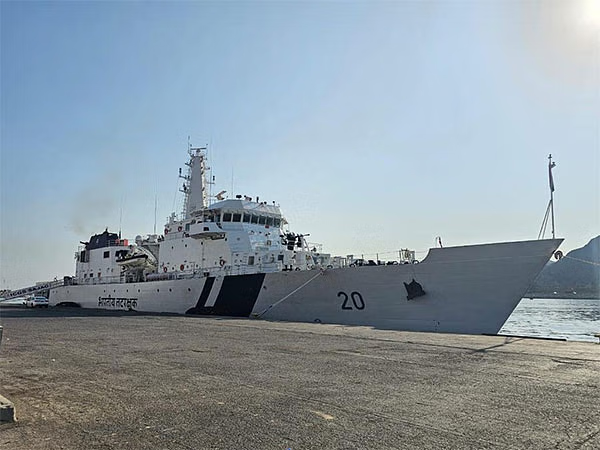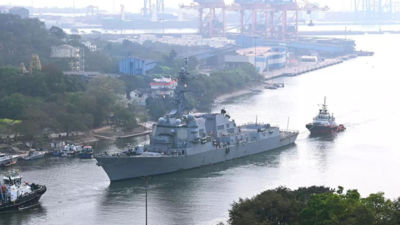Description

Disclaimer: Copyright infringement not intended.
Context
- Indian Coast Guard Ship Sajag, an Offshore Patrol Vessel, arrived at Port Sultan Qaboos, Muscat, Oman for a three-day visit as part of the overseas deployment of ICG ships to West Asia.
Details
- ICGS Sajag is an integral part of the Indian Coast Guard's fleet of Offshore Patrol Vessels (OPVs), stationed on the West Coast of India in Porbandar, Gujarat.
Operational Details
- Location: Based on the West Coast in Porbandar, Gujarat, ICGS Sajag operates under the operational command of the Commander Coast Guard Region (North West).
- Operational Roles: It actively participates in various Coast Guard operations, including coastal security, surveillance of International Maritime Boundary Line (IMBL) / Exclusive Economic Zone (EEZ), anti-transnational crimes, maritime Search and Rescue (SAR) operations, and pollution response efforts.

Design and Construction
- Indigenous Design and Construction: Goa Shipyard Limited (GSL) designed and built ICGS Sajag indigenously as part of the Samarth-class offshore patrol vessels.
- Series of OPVs: It is the third vessel in the series of 105-meter OPVs being constructed by GSL for the Indian Coast Guard.
- Aim and Initiation: The construction was initiated as part of a significant expansion of the Coast Guard's assets and infrastructure following the 2008 Mumbai attacks.
Features and Capabilities
- Advanced Technology: Equipped with state-of-the-art weapon systems, sensors, and cutting-edge navigation and communication systems.
- Propulsion and Speed: Powered by two 9100 KW diesel engines, the vessel can achieve a maximum speed of 26 knots and has an endurance of 6000 nm at an economical speed.
- Armament: Includes a 40/60 Bofors gun and two 12.7 mm guns for defense purposes.
- Helicopter and Boats: Designed to accommodate one twin-engine helicopter and four high-speed boats, two of which are inflatable boats used for various operations such as boarding, search and rescue, law enforcement, and maritime patrol.
- Pollution Response: Capable of carrying pollution response equipment to manage oil spills and contamination at sea.
- Advanced Systems: Fitted with an Integrated Bridge System (IBS), Integrated Platform Management System (IPMS), Power Management System (PMS), and High-Power External Firefighting (EFF) system.
- Specifications: The Samarth-class OPVs are 105 meters (344 ft 6 in) long and have a displacement of 2,350 tonnes.
About Samarth-class OPVs
Construction and History:
- Motivation: Triggered by the 2008 Mumbai attacks, the Indian Government launched a program to expand the Coast Guard's capabilities, resulting in the Samarth class construction.
- These vessels are an improvement over the earlier Sankalp class, featuring a larger beam and more powerful engines.
- Order Batches: Constructed in two batches, the first batch consisted of six OPVs ordered in May 2012, completed by December 2017. A follow-on batch of five vessels was ordered in August 2016.
- Contract and Construction Commencement: After technical evaluations and bids, GSL secured a $400 million contract on 9 May 2012 to build six vessels. The construction began with the first steel cutting on 14 May 2012, followed by the keel-laying ceremony in Vasco da Gama on 28 September 2012.
- Progress and Commissions: The construction timeline saw notable milestones, including the commissioning of the first vessel on 10 November 2015 and the subsequent commissioning of all six by the end of 2017. Subsequent vessels of the follow-on batch were commissioned in a timely manner, some even ahead of schedule.

Features and Description:
- Specifications: Each vessel of the Samarth class is 105 meters (344 ft 6 in) long with a displacement of 2,350 tonnes.
- Integrated Systems: Equipped with advanced systems like Integrated Bridge System, Integrated Machinery Control System, Power Management System, and High Power External Fire Fighting System.
- Operational Capabilities: Designed to carry one twin-engine Light Helicopter and five high-speed boats, including two Palfinger QRIBs for diverse operations such as fast boarding, search and rescue, law enforcement, and maritime patrol.
- Pollution Response: These vessels are equipped to handle oil spill contamination at sea, carrying pollution response equipment for environmental emergencies.
|
PRACTICE QUESTION
Q. Which of the following statements are true regarding the Samarth-class offshore patrol vessels constructed for the Indian Coast Guard?
1.The Samarth class was built as part of a program to triple the Coast Guard assets following the 2008 Mumbai attacks.
2.These vessels are an improvement over the earlier Sankalp class, featuring a larger beam and more powerful engines.
3.The Samarth-class vessels were constructed in three batches by Mazagon Dock Shipbuilders Limited.
a) Only statements 1 and 2 are correct.
b) Only statement 2 is correct.
c) Only statement 3 is correct.
d) Statements 1, 2, and 3 are all correct.
Correct answer: d)
|















